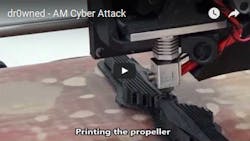Ben-Gurion University of the Negev, University of South Alabama, and Singapore University of Technology researchers combined their expertise to demonstrate the first complete sabotage attack on a 3D additive manufacturing (AM) system, illustrating how a cyber attack and malicious manipulation of blueprints can fatally damage production of a device or machine. The details are contained in their paper titled "Dr0wned".
RELATED ARTICLE: How does additive manufacturing 'stack up' against subtractive methods?
A proof-of-concept video shows how the researchers destroyed a $1,000 quadcopter unmanned aerial vehicle or UAV drone by hacking into the computer used to control the 3D printing of replacement propellers. Once they penetrated the computer, the researchers identified the propeller blueprint file and inserted defects undetectable by visual inspection. During flight tests, the sabotaged propeller broke apart during ascent, causing the drone to smash into the ground.
More than 100 industries, including aerospace, automotive and defense, use AM processes. According to the Wohlers Report, the AM industry accounted for $5.165 billion of revenue in 2015. Furthermore, 32.5% of all AM-generated objects are used as functional parts.
"Imagine that an adversary can sabotage functional parts employed in an airplane’s jet engines. Such an attack could cost lives, cause economic loss, disrupt industry, and threaten a country’s national security,” says professor Yuval Elovici of BGU.
"With the growth of additive manufacturing worldwide, we believe the ability to conduct malicious sabotage of these systems will attract the attention of many adversaries, ranging from criminal gangs to state actors, who will aim either for profit or for geopolitical power," says Elovici.
The collaborative study addresses the dangerous consequences of cyber attacks, and proposes a systematic approach for identifying opportunities and a methodology for assessing the level of difficulty of an attack involving AM.
SOURCE: Ben-Gurion University of the Negev; http://in.bgu.ac.il/en/Pages/news/hacking_3d.aspx

Gail Overton | Senior Editor (2004-2020)
Gail has more than 30 years of engineering, marketing, product management, and editorial experience in the photonics and optical communications industry. Before joining the staff at Laser Focus World in 2004, she held many product management and product marketing roles in the fiber-optics industry, most notably at Hughes (El Segundo, CA), GTE Labs (Waltham, MA), Corning (Corning, NY), Photon Kinetics (Beaverton, OR), and Newport Corporation (Irvine, CA). During her marketing career, Gail published articles in WDM Solutions and Sensors magazine and traveled internationally to conduct product and sales training. Gail received her BS degree in physics, with an emphasis in optics, from San Diego State University in San Diego, CA in May 1986.
